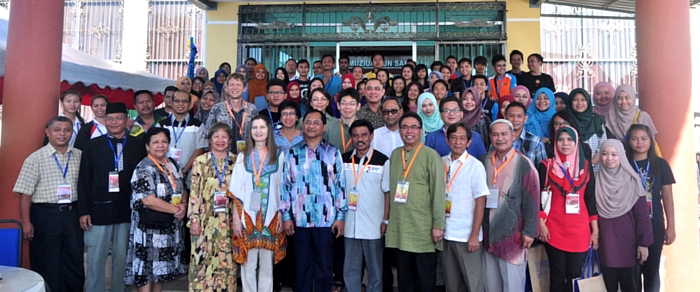
Photo courtesy of Hairul.
Two Asian Center faculty presented their research the International Conference on Bajau/Sama Diaspora and Maritime Southeast Asian Cultures” held from 19 to 24 April 2016 at the Tun Sakaran Museum in Semporna, Sabah.
Professor MCM Santamaria discussed “Pagjamu Boheh Deya:Interrogating ‘Property’ in the Sama Tabawan Music and Dance Ritual of the Sacred Well.” Below is the abstract of his paper:
The Pagjamu Boheh Deya is a Sama ritual held at the site of the sacred well in the Island of Tabawan, Municipality of South Ubian, Tawi-Tawi Province, southern Philippines. The ritual allows members of the Sama Tabawan community to offer music and dances to their ancestors, omboh, who in turn are believed to watch over the general welfare of the community. This paper attempts to relate ritual to notions of property; the ritual itself as property of a clan; the ritual site as property of a specific family; and ritual implements and performances of music and dance as individual contributions of “property” to the ritual process. Ritual ownership, in a sense, is seen to tie the community to its cosmological realm via roles performed by specific families and individuals. It also helps create a sense of rootedness in place via the reassertion of the sacredness and therefore inviolability of sites. Furthermore, individual contributions to the ritual process permit the development of a collective sense of belonging that in the long run strengthen the idea of community. Part 1 introduces Sama rituals in the community of Tabawan Island. It also briefly discusses the importance of Tabawan Island in the cosmology of the people. Part 2 examines the Pagjamu Boheh Deya ritual as a property “owned” by a particular family among the Sama Tabawan. Afterwards, it discusses the various ritual phases of the Pagjamu Boheh Deya ritual. Part 3 examines various types of property associated with the Pagjamu Boheh Deya ritual. It critiques etic views of property and presents an alternative emic view that centers on function and sense of responsibility.
Meanwhile, Rolando Talampas, Associate Professor and College Secretary at the UP Asian Center, discussed “Sama Di Laut Migration and the Politics of Inclusion”. Below is the abstract of his paper:
Since the 1970s, thousands of Sama-speaking people of southern Philippines have migrated due to conflict, poverty, piracy, discrimination and in search for better opportunities. More as refugees rather than migrants, they have landed in urban areas of Mindanao (notably Zamboanga City which some of them claim was derived from Sama word meaning moorage), the Visayas (notably Cebu and Dauis in Bohol island province), and Metro Manila and further north (e.g. Cabanatuan City). Until recent efforts by the Department of Social Welfare and Development (DSWD) yielded a broad initiative for their “re-integration,” only incremental improvements in their residence and livelihood differed from their original conditions.
This paper details how some elements of local politics of Sama Di Laut’s host areas have come to actualize the meaning of “re-integration,” a term not too infrequently rejected by those who believe that the Sama were never really integrated after all, that is, if the Sama themselves willed it. By comparing how the local governments of Cabanatuan and Cebu cities, on the one hand, and those of Pampanga province and the city of Manila, on the other, have responded to Sama Di Laut presence in their midst, this paper argues that Philippine local (and national politics) will take long to realize inclusive development for one of the most marginalized ethnic groups in Philippine society. Sama Di Laut’s own social inclusion can only be with consistently good governance.
Carrying the theme “Bajau/Sama Diaspora and Maritime Southeast Asian Cultures,” the conference featured papers on migration, politics, rituals, performing arts, heritage, material culture, language and identity of the Bajau-Sama diaspora and maritime Southeast Asian peoples. The conference was organized by the Nusantra Performing Arts Research Centre (NusPacr) in partnership with the Sabah Museum, Tun Sakaran Museum, and Kadazan Dusun Chair, Universiti Malaysia Sabah.
The UP Asian Center offers M.A. degrees in Asian Studies with four fields of specialization: Northeast Asia, Southeast Asia, South Asia, and West Asia. The Center also has an M.A. program in Philippine Studies that allows students to major in Philippine society and culture, Philippine foreign relations, or Philippine development studies. The Center offers a Ph.D. program in Philippine Studies in conjunction with the College of Arts and Letters and the College of Social Sciences and Philosophy. Get an overview of these programs. The Asian Center also houses a peer-reviewed, open-access journal, Asian Studies: Journal of Critical Perspectives on Asia. It has published several books and monographs, and hosts or organizes various lectures and conferences.

